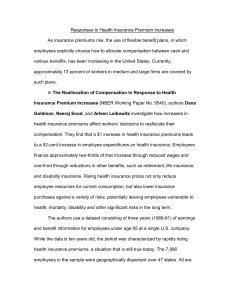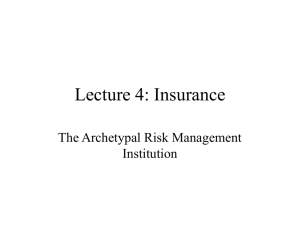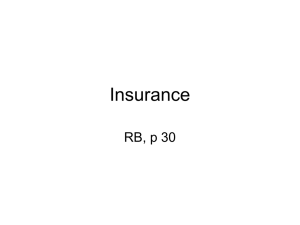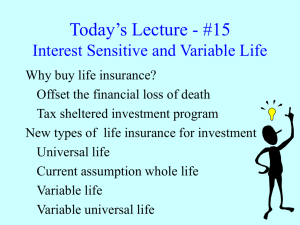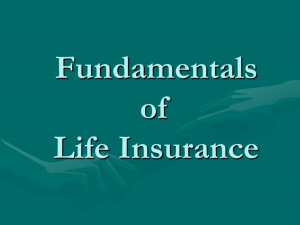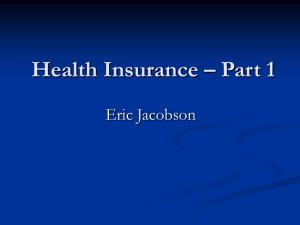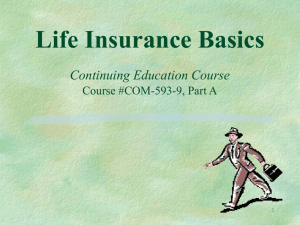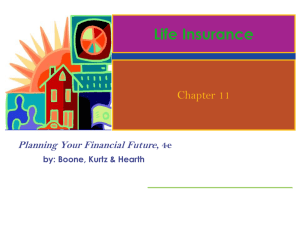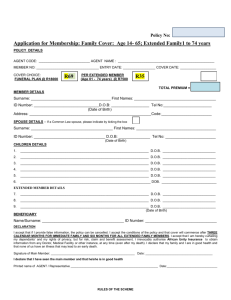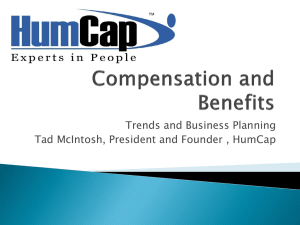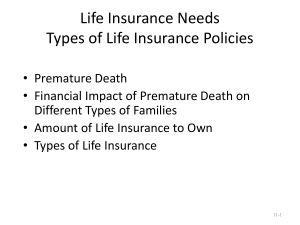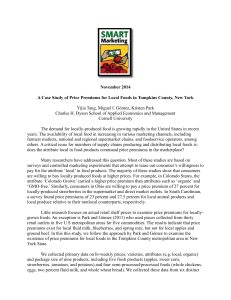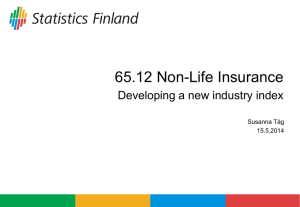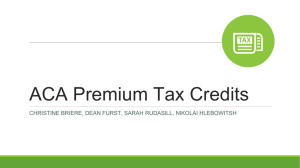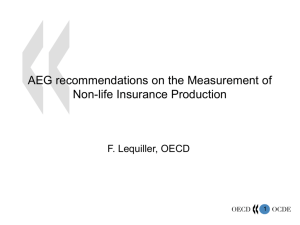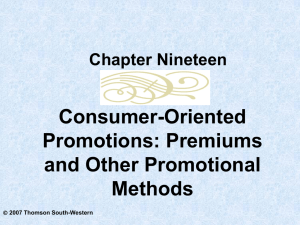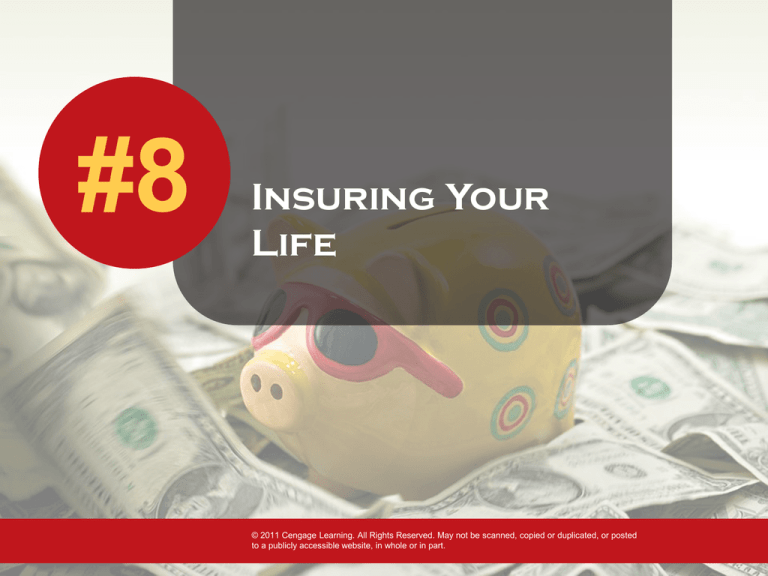
#8
Insuring Your
Life
© 2011 Cengage Learning. All Rights Reserved. May not be scanned, copied or duplicated, or posted
to a publicly accessible website, in whole or in part.
Basic Insurance Concepts
Basic purposes of insurance
• Protect you and dependents from losing
your acquired assets
• Shield you and your family from an
interruption in earnings
The Concept of Risk
Risk:
chance of
economic
loss
Insurance planning:
reduces risk that
losses will
cause financial
devastation
The Concept of Risk
Risk Avoidance – Avoiding an act that
would create a risk
Example: not driving to avoid car accident
Risk avoidance is not always
practical or possible
Loss Prevention and Control
Prevention - reduce
chance that loss
will occur
Example: Driving
the speed limit
may reduce
likelihood of car
accident
Control - reduce
severity of loss once
it occurs
Example: Wearing a
seat belt can
minimize effects of
an accident
The Concept of Risk
Assuming Risk
choice to accept
and bear the risk of
loss yourself
Example: Bear the
cost of replacing
stolen calculator
Insurance
pay someone to
bear your risk of
loss
Example: Buy an
insurance policy to
transfer risk to
insurance company
Underwriting Basics
• Insurance company decides whom to
insure and rate to be charged
• Company must guard against
adverse selection a disproportionate
number of bad risks
Benefits of Life Insurance
•
•
•
•
Financial protection for dependents
Protection from creditors
Tax benefits
Vehicle for savings
Do You Need Life Insurance?
Consider if
• Dependents count
on your financial
support
• You have debts
– home mortgage
Maybe Not if
• No one
depends on
your support
• You are a
child
How Much Life Insurance is
Right for You
Multiple-ofEarnings
Method
• Multiply annual
earnings by an
arbitrary number
Needs Analysis
Method
• Estimate needs
and examine
available
resources
How Much Life Insurance
Is Right For You?
Assess Family’s Total Economic
Needs
• Family income
• Additional expenses
• Special needs of
dependents
• Pay off debts
• Liquidity
Determine Financial Resources
•
•
•
•
•
•
Savings and investments
Social Security benefits
Pension or retirement plans
Other life insurance
Income of surviving spouse or children
Real estate or other assets
Subtract Resources
From Needs
This is the amount of life
insurance needed to
provide your family with
desired standard of living
Term Life Insurance
• Specified amount of insurance protection
for a set period
• Benefit paid if insured dies during that time
• Simplest type of insurance policy
Types of Term Insurance
Straight term
Coverage
remains the same
while premiums
can increase
Decreasing term
Premiums remain
the same while
coverage
decreases
Important Features In Term
Insurance
Renewability
Renew policy
without evidence
of insurability
Convertibility
Convert to whole
life policy without
evidence of
insurability
Representative Annual Renewable Term Life
Insurance Premiums: $100,000 Policy,
Preferred Nonsmoker Rates
Term Insurance
Advantages
Disadvantages
• Economical way for
young families to
purchase large
amounts of life
insurance
• Provides for needs that
disappear over time
• Premiums
become more
costly as you get
older
• Does not build
cash value
Whole Life Insurance
Cash value
Provides death
protection plus a
savings feature
Nonforfeiture
right
Right to cash
value when
canceled prior
to death
How Cash Value Accumulates In A $200,000
Whole Life Policy
Representative Whole Life Insurance
Premiums: $100,000 Policy, Preferred
Nonsmoker Rates
Types of Whole Life Policies
Continuous premium (straight life)
• Level premiums paid until death or policy
cancellation
Limited payment
• Level premiums paid for specified number
of years, insurance in force until death
Single premium
• Lifetime coverage purchased with a single
premium
Advantages of Whole Life
Advantages
• Savings vehicle
• Borrow against cash value
• Premiums remain constant
• Cash value accumulates tax-free
until redeemed
Disadvantages of Whole Life
Disadvantages
• Less death protection for young people
• Low return on savings
• Tax penalties possible on early
withdrawal
• Outstanding loan subtracted from face
value of policy upon death
Universal Life Insurance
• Permanent cash-value insurance that
combines term insurance with tax sheltered
savings account
• Provides death protection plus savings feature
• Premiums are “unbundled” into 2 accounts
• Savings grow at current interest rate vs.
guaranteed minimum rate
• Provides flexibility in premiums paid and death
benefit
Understand the risks before you buy!
Representative Universal Life Insurance
Annual Outlays: $100,000 Policy, Preferred
Nonsmoker Rates
Other Types of Life Insurance
Variable life insurance
• Provides death protection plus a
savings or cash value feature
• Cash value can be invested in mutual
funds for greater possible return
• Returns not guaranteed and actual
death benefit can vary
Representative Variable Life Insurance
Values: $100,000 Policy,
Preferred Nonsmoker, Male, Age 45
Other Types of Life Insurance
Variable life
insurance
• Combines flexibility
of premium payment
feature of universal
with investment
choices offered by
variable
Group life insurance
• Usually term
insurance offered
through employers
• Premiums usually
lower than individually
purchased policies
Other Special-Purpose
Life Insurance
Credit and Mortgage life
insurance
• Decreasing term insurance
• Pays off outstanding
balance if borrower dies
before repaid
• Costly form of coverage
Industrial life
insurance
• Whole life
policies with
small face
amounts
• For low-income
families
Buying Life Insurance
• Compare costs and
features
• Select a large, highly
rated, financially secure
company
• Choose a reputable
agent
Key Features of Various Types of
Life Insurance
Life Insurance Contract Features
Beneficiary clause
Settlement options
Policy loans
Premium payments
Grace period
Nonforfeiture options
Policy reinstatement
Change of policy
Other Policy Features
Multiple indemnity
Disability clause
Guaranteed purchase options
Suicide clause
Exclusions
Participation
Living benefits
Viatical Settlement



